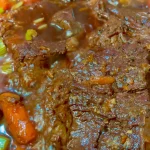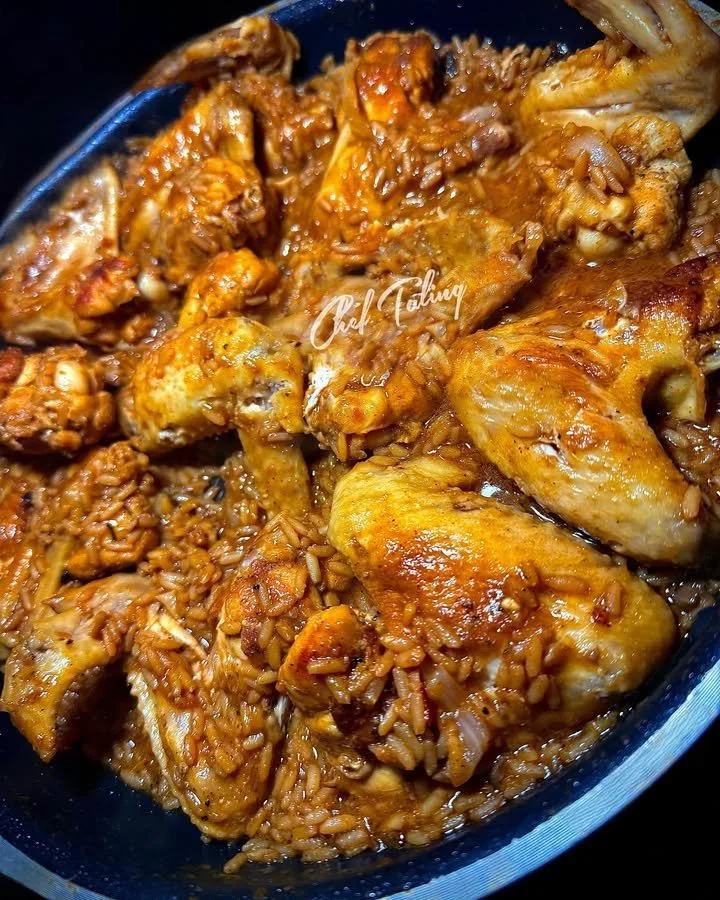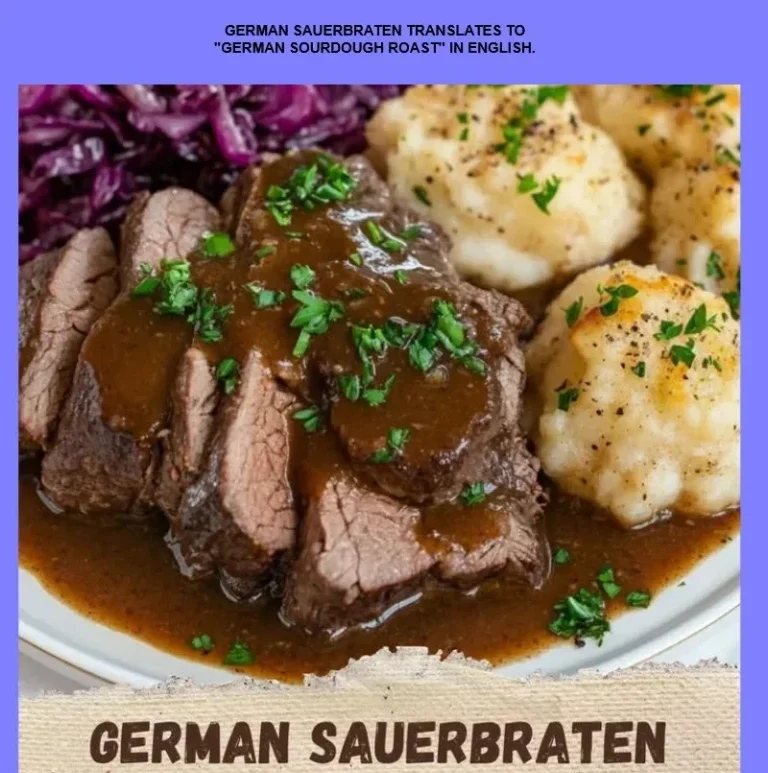The Best German Sauerbraten


The Best German Sauerbraten — Easy, Traditional & Homemade (Healthy Options!)
A warm, vinegary hug for your taste buds: The Best German Sauerbraten is a classic pot roast that’s tangy, savory, and downright comforting. I still remember the smell that filled my grandmother’s kitchen — slow-simmered beef, sweet-sour sauce, and the promise of Sunday dinner — and this recipe brings that cozy feeling right into your home. Serve it for a weekend family meal, holiday gathering, or a special weeknight when you want something satisfying and a little nostalgic.
🧂 Ingredients
- 3 to 4 pounds beef roast (rump roast, chuck, or bottom round — or venison for a leaner, gamey twist)
- 2 cups dry red wine
- 1 cup red wine vinegar (or apple cider vinegar for a milder tang)
- 1 cup beef broth or water
- 2 large onions, sliced
- 2 carrots, sliced
- 2 celery stalks, sliced
- 3 cloves garlic, smashed
- 2 tablespoons brown sugar (or maple syrup / honey)
- 2 bay leaves
- 6 whole cloves OR 1/2 teaspoon ground cloves
- 1 teaspoon whole black peppercorns, lightly crushed
- 6 juniper berries (optional, traditional flavor)
- 1 tablespoon pickling spice (optional)
- 2 tablespoons neutral oil (vegetable, canola, or light olive oil) for browning
- 2 cups crushed gingersnaps OR 2 tablespoons cornstarch (or arrowroot) for thickening
- Salt and freshly ground black pepper, to taste
Quick version (if short on time): you can marinate for 24 hours (see tips below) — but the traditional depth comes from 3–5 days.
👩🍳 Directions
- Make the marinade: In a large bowl, whisk together red wine, red wine vinegar, beef broth (or water), sliced onions, carrots, celery, garlic, brown sugar, bay leaves, cloves, peppercorns, juniper berries, and pickling spice if using.
- Marinate the beef: Place the beef in a non-reactive container or large zip-top bag and pour the marinade over it, making sure the meat is submerged. Cover and refrigerate for 3–5 days, turning the meat once a day. (Quick option: marinate 24 hours and it will still be delicious.)
- Remove and reserve: Take the beef out of the marinade, pat it dry with paper towels, and strain the marinade through a fine sieve into a bowl. Reserve both solids and liquid. Season the beef with salt and pepper.
- Brown the roast: In a heavy Dutch oven or ovenproof pot, heat the oil over medium-high heat. Brown the roast on all sides (about 3–4 minutes per side) to develop flavor. Transfer the roast to a plate.
- Sauté veggies and reduce marinade: Add the strained onions, carrots, and celery to the pot and sauté for 5–7 minutes until slightly softened. Pour in the reserved marinade liquid and bring to a simmer, scraping up any browned bits. Simmer 8–10 minutes to meld flavors.
- Braise: Return the roast to the pot. Add extra beef broth if needed to come halfway up the side of the roast. Cover and braise:
- On the stovetop: simmer gently on low for 2.5–3 hours.
- In the oven: preheat to 325°F (160°C) and cook covered for 2.5–3 hours.
The roast is done when a fork slides in easily.
- Make the gravy: Remove the roast and keep warm. Strain the braising liquid into a saucepan, pressing the solids to release juices. Bring to a simmer. For a classic thickener, stir in crushed gingersnaps a handful at a time until you reach desired thickness and sweetness. For a smoother, gluten-free gravy, whisk 1–2 tablespoons cornstarch or arrowroot with cold water and simmer for 2–3 minutes until thickened. Adjust seasoning.
- Slice and serve: Slice the roast thinly across the grain, arrange on a platter, and spoon the gravy over the meat. Simmer leftover gravy a few minutes more if needed to meld flavors.
Cooking tip: If the sauce tastes too sharp from the vinegar, simmer a little longer or add a teaspoon of honey/maple syrup to balance acidity.
💡 Tips & Variations
- Traditional vs. Quick: Traditional marinating (3–5 days) yields the deepest flavor. If short on time, 24 hours still gives great results.
- Healthier swaps:
- Use a leaner cut (bottom round) or venison for lower fat and higher protein.
- Replace brown sugar with a smaller amount of maple syrup or a sugar substitute for fewer calories.
- Thicken with arrowroot instead of cornstarch if you prefer cleaner starch.
- Low-carb / Keto: Skip the gingersnaps. Use arrowroot/cornstarch very sparingly or serve sauce as-is. Serve with cauliflower mash or roasted Brussels sprouts instead of potatoes.
- Gluten-free: Use certified gluten-free gingersnaps or thicken with cornstarch/arrowroot. Also ensure your broth is gluten-free.
- Vegan version: Try a mushroom “roast” — use a whole roasted cauliflower or seared portobello steaks marinated in the same sauce, and thicken with puréed white beans or blended cooked potato for body. Use vegetable broth instead of beef.
- Serving ideas: Classic sides include buttered spaetzle, mashed potatoes, red cabbage (Rotkohl), green beans, or braised red cabbage. A crusty rye or sourdough is lovely for soaking up sauce.
- Make-ahead & storage: Sauerbraten actually improves overnight. Refrigerate leftovers in an airtight container for 3–4 days, or freeze up to 3 months. Reheat gently on low to avoid drying the meat.
- Leftover inspiration: Thinly sliced Sauerbraten makes exceptional sandwiches with mustard and pickles or served over spaetzle the next day.
🩺 Health & Lifestyle Tie-in
Beef Sauerbraten can be a good source of protein, iron, and B vitamins — important for energy and muscle repair. Choosing lean cuts and limiting added sugar keeps it heart-friendlier. Cooking homemade meals like this not only nourishes the body but can save money compared with frequent dining out — small lifestyle changes like cooking more often can contribute to better health outcomes and potentially reduce future health-related expenses. Eating well now can be part of a smart approach to personal wellness and financial wellbeing.
❤️ Conclusion
There’s something deeply comforting about The Best German Sauerbraten — the slow-braised tenderness and that sweet-sour gravy that makes people reach for seconds. Give the traditional 3–5 day marinade a try when you have the time, or the quick 24-hour version on a busy weeknight. If you make this dish, let me know in the comments or tag me — I’d love to see your version and hear your family stories!
#fblifestyle


German Sauerbraten
Ingredients
Method
- Make the marinade: In a large bowl, whisk together red wine, red wine vinegar, beef broth (or water), sliced onions, carrots, celery, garlic, brown sugar, bay leaves, cloves, peppercorns, juniper berries, and pickling spice if using.
- Marinate the beef: Place the beef in a non-reactive container or large zip-top bag and pour the marinade over it, making sure the meat is submerged. Cover and refrigerate for 3–5 days, turning the meat once a day. (Quick option: marinate 24 hours and it will still be delicious.)
- Remove and reserve: Take the beef out of the marinade, pat it dry with paper towels, and strain the marinade through a fine sieve into a bowl. Reserve both solids and liquid. Season the beef with salt and pepper.
- Brown the roast: In a heavy Dutch oven or ovenproof pot, heat the oil over medium-high heat. Brown the roast on all sides (about 3–4 minutes per side) to develop flavor. Transfer the roast to a plate.
- Sauté veggies and reduce marinade: Add the strained onions, carrots, and celery to the pot and sauté for 5–7 minutes until slightly softened. Pour in the reserved marinade liquid and bring to a simmer, scraping up any browned bits. Simmer 8–10 minutes to meld flavors.
- Braise: Return the roast to the pot. Add extra beef broth if needed to come halfway up the side of the roast. Cover and braise: On the stovetop: simmer gently on low for 2.5–3 hours; In the oven: preheat to 325°F (160°C) and cook covered for 2.5–3 hours. The roast is done when a fork slides in easily.
- Make the gravy: Remove the roast and keep warm. Strain the braising liquid into a saucepan, pressing the solids to release juices. Bring to a simmer. For a classic thickener, stir in crushed gingersnaps a handful at a time until you reach desired thickness and sweetness. For a smoother, gluten-free gravy, whisk 1–2 tablespoons cornstarch or arrowroot with cold water and simmer for 2–3 minutes until thickened. Adjust seasoning.
- Slice and serve: Slice the roast thinly across the grain, arrange on a platter, and spoon the gravy over the meat. Simmer leftover gravy a few minutes more if needed to meld flavors.











